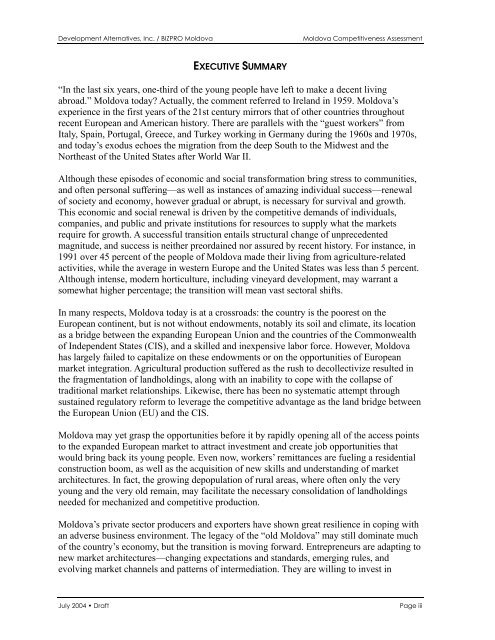Assessing Competitiveness In Moldova's Economy - Economic Growth
Assessing Competitiveness In Moldova's Economy - Economic Growth
Assessing Competitiveness In Moldova's Economy - Economic Growth
Create successful ePaper yourself
Turn your PDF publications into a flip-book with our unique Google optimized e-Paper software.
Development Alternatives, <strong>In</strong>c. / BIZPRO Moldova Moldova <strong>Competitiveness</strong> Assessment<br />
EXECUTIVE SUMMARY<br />
“<strong>In</strong> the last six years, one-third of the young people have left to make a decent living<br />
abroad.” Moldova today? Actually, the comment referred to Ireland in 1959. Moldova’s<br />
experience in the first years of the 21st century mirrors that of other countries throughout<br />
recent European and American history. There are parallels with the “guest workers” from<br />
Italy, Spain, Portugal, Greece, and Turkey working in Germany during the 1960s and 1970s,<br />
and today’s exodus echoes the migration from the deep South to the Midwest and the<br />
Northeast of the United States after World War II.<br />
Although these episodes of economic and social transformation bring stress to communities,<br />
and often personal suffering—as well as instances of amazing individual success—renewal<br />
of society and economy, however gradual or abrupt, is necessary for survival and growth.<br />
This economic and social renewal is driven by the competitive demands of individuals,<br />
companies, and public and private institutions for resources to supply what the markets<br />
require for growth. A successful transition entails structural change of unprecedented<br />
magnitude, and success is neither preordained nor assured by recent history. For instance, in<br />
1991 over 45 percent of the people of Moldova made their living from agriculture-related<br />
activities, while the average in western Europe and the United States was less than 5 percent.<br />
Although intense, modern horticulture, including vineyard development, may warrant a<br />
somewhat higher percentage; the transition will mean vast sectoral shifts.<br />
<strong>In</strong> many respects, Moldova today is at a crossroads: the country is the poorest on the<br />
European continent, but is not without endowments, notably its soil and climate, its location<br />
as a bridge between the expanding European Union and the countries of the Commonwealth<br />
of <strong>In</strong>dependent States (CIS), and a skilled and inexpensive labor force. However, Moldova<br />
has largely failed to capitalize on these endowments or on the opportunities of European<br />
market integration. Agricultural production suffered as the rush to decollectivize resulted in<br />
the fragmentation of landholdings, along with an inability to cope with the collapse of<br />
traditional market relationships. Likewise, there has been no systematic attempt through<br />
sustained regulatory reform to leverage the competitive advantage as the land bridge between<br />
the European Union (EU) and the CIS.<br />
Moldova may yet grasp the opportunities before it by rapidly opening all of the access points<br />
to the expanded European market to attract investment and create job opportunities that<br />
would bring back its young people. Even now, workers’ remittances are fueling a residential<br />
construction boom, as well as the acquisition of new skills and understanding of market<br />
architectures. <strong>In</strong> fact, the growing depopulation of rural areas, where often only the very<br />
young and the very old remain, may facilitate the necessary consolidation of landholdings<br />
needed for mechanized and competitive production.<br />
Moldova’s private sector producers and exporters have shown great resilience in coping with<br />
an adverse business environment. The legacy of the “old Moldova” may still dominate much<br />
of the country’s economy, but the transition is moving forward. Entrepreneurs are adapting to<br />
new market architectures—changing expectations and standards, emerging rules, and<br />
evolving market channels and patterns of intermediation. They are willing to invest in<br />
July 2004 • Draft Page iii
















